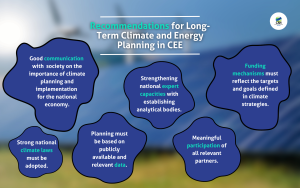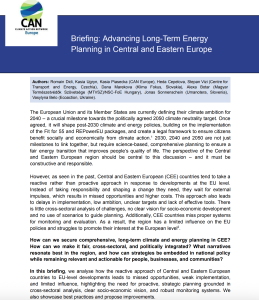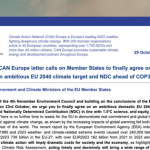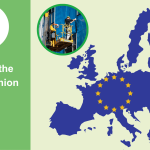The EU and its Member States are setting their climate ambition for 2040 – a crucial milestone for accelerated action on the path to climate neutrality. It is essential that the perspectives of Central and Eastern European (CEE) countries – and the ways in which they are positioned and supported to contribute constructively to ambitious targets – play a central role in this process. However, local experts point out that CEE countries have often responded to, rather than shaped, EU climate initiatives – missing opportunities to be early-movers and facing higher costs as a result. Taking ownership of their climate strategies is vital if these plans are to drive meaningful and lasting change.
How can we secure comprehensive, long-term climate and energy planning in CEE? How can we make it fair, cross-sectoral, and politically integrated? What narratives resonate best in the region, and how can strategies be embedded in national policy while remaining relevant and actionable for people, businesses, and communities?
In this briefing, CAN Europe with its members in the CEE region analyse how the reactive approach of Central and Eastern European countries to EU-level developments leads to missed opportunities, weak implementation, and limited impact, highlighting the need for proactive, strategic planning grounded in cross-sectoral analysis, clear socio-economic vision, and robust monitoring systems. We also showcase best practices and propose improvements.
CEE and climate policy: the price of procrastination
Most CEE countries lack a coordinated, long-term climate vision. Few use their 2030 National Energy and Climate Plans strategically to drive reforms or guide EU-funded investments. Plans for 2040 or 2050 are often seen as abstract rather than actionable. Many governments avoid serious debate on the 2040 target, treating it merely as a midpoint between 2030 and 2050. At the EU level, Poland, Czechia, Slovakia, and Hungary question the target’s ambition, while Romania and Bulgaria remain noncommittal. Domestically, focus on meeting 2030 goals continues to shape the region’s longer-term climate path.
Central and Eastern European countries have consistently struggled to deliver effective long-term climate and energy planning.
This is largely due to a combination of persistent challenges, including a lack of political continuity, limited cross-party consensus, insufficient analytical capacity, and the absence of clear strategic visions and milestones. Political barriers further complicate the development of coherent and forward-looking plans.
Despite the complex political landscape in the region, recent Eurobarometer data clearly shows that citizens across CEE support climate goals and are calling for more decisive action. It is therefore imperative that policymakers acknowledge this public support, assume ownership of national climate strategies, and take responsible, forward-looking action.
Barriers to Implementing long-term planning in CEE
When developing climate and energy strategies, Central and Eastern European countries often tend to perceive it as a “box-ticking” exercise, only fulfilling the European Union’s obligations. These strategies usually lack a clear long-term vision and focus on short-term developments. As a result, climate action tends to drift without strong direction or planning.
🔮 Lack of concrete vision for a long term, people-centred climate action
Long-term climate and energy planning in CEE is largely reactive to EU obligations and remains vague. While visions may outline 2050 climate neutrality, they lack milestones, concrete policies, investment analysis, and clear stakeholder guidance – hindering monitoring, evaluation, and adjustment. A jointly designed vision is needed to benefit national economies and citizens.
🗣️ Lack of continuity and political consensus
In the CEE region, long-term planning faces political challenges, as successive governments pursue only their own ideas without cross-party consensus. Governments only consider the timeframe of their current mandate and ignore the importance of long-term planning. A climate law is crucial here, providing regulatory stability for policies that deliver results over decades.
📉 Lack of analytical capacities
Turning a vision and strategy into law and concrete action requires strong analytical capacities, including identifying challenges, opportunities, and priorities. In the region, many public institutions lack this ability, often outsourcing strategy development to external actors whose perspectives dominate the outcomes.
🧩 Lack of coherence
Many CEE countries have numerous general strategies from different administrative bodies, often lacking coherence at national, regional, and local levels. Without an overarching vision, measures can contradict or conflict with each other. An expert advisory body could help address this.
👥 Lack of engagement of relevant actors
Stakeholder involvement is often weak. Strategy development must be open to input from diverse groups—local and regional policymakers, businesses, trade unions, communities, citizens, and civil society – and include broad dialogue and clear mechanisms to integrate their perspectives.
🤝 Lack of coordination
Even when a concrete strategy is developed, usually by one ministry, collaboration with other public institutions is weak or competitive. Lacking a horizontal approach and clear authority, actors work in silos, with no central body to coordinate progress toward a shared vision.
📣 Lack of targeted communication
There is a need to explain, using well-defined arguments and narratives, how certain industries, business sectors, regions, and social groups can become part of the transition. When communication does happen, it is often driven by short-term political goals rather than any clear strategy.
Solutions: Recommendations for climate planning in CEE

Coherent climate planning that produces actionable strategies and concrete measures at national, regional, and local levels is essential for clarity and predictability. This benefits citizens and businesses, including industry, by enabling long-term investment decisions and fostering competitive green growth across CEE.
- Planning must be based on publicly available and relevant data.
- Climate strategies should be prepared in a process with meaningful participation of all relevant stakeholders.
- Strong national climate laws must be adopted, including the updated nLTS, in line with the updated NECPs and the current EU 2030 climate and energy targets and the EU climate neutrality target by 2050.
- National capacities must be strengthened – countries need national analytical bodies with sufficient and relevant expert capacity to ensure independent and continuous background for a coherent planning.
- Funding mechanisms must be updated to reflect the targets and goals defined in climate strategies (e.g. programmes funded by EU ETS revenues, JTF, Modernisation Fund, SCF).
- Good communication is key: the importance of climate planning and implementation (decarbonisation, green transformation measures) for the national economy must be clearly and consistently communicated to the society.




